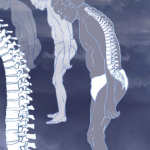Differences in Disease Presentation
Women with axial spondyloarthritis tend to have more peripheral complaints, like joint pain, compared with men, who predominantly experience lower back pain with less peripheral involvement. “We also see more enthesitis in women compared with men overall. So that may also be an important factor delaying the diagnosis in women,” Dr. van der Horst-Bruinsma states. More women also seem to experience widespread pain and coexisting inflammatory bowel disease; in contrast, more men display symptoms of anterior acute uveitis. Women seem to be more likely to have cervical and neck pain than men. Thus women are less likely to present with the classic symptoms of the disease characterized by inflammatory type lower back pain.7
Literature reviews demonstrate that, on average, women with radiographic axial spondyloarthritis seem to have fewer radiographic changes and show less progression compared with men. However, this does not appear to directly correlate with severity of symptoms, as evidence from several studies suggests that as a group, women may actually experience a higher symptom burden compared with men.7,12 Dr. van der Horst-Bruinsma stresses the disease can be severe in women.
Diagnostic Delay
The differences in symptom manifestations may contribute to diagnostic delay in women. In general, ankylosing spondylitis has been associated with diagnostic delay, often first misdiagnosed as more common but less serious disorders like non-specific chronic low back pain.13 Women with axial spondyloarthritis appear to experience greater diagnostic delay than men, though this interval may have decreased over the past few decades.1 Yet in a recent study published in PLoS One, Dr. Jovani et al. observed that one-third of males were correctly diagnosed in their first visit to a healthcare provider, but only a tenth of women were.14 A 2016 meta-analysis found a delayed diagnosis of 8.8 years for women compared with 6.5 years for men.15
Symptom overlap with other possible conditions can confuse the issue. Dr. Jovani notes some female patients may be mistakenly referred to gynecologists, surgeons, gastroenterologists or psychiatrists. “Some symptoms of spondyloarthritis, such as low back pain, morning stiffness and sleep disorders associated with pain, are shared with fibromyalgia. Often, these symptoms in women are not regarded as having the same meaning as similar symptoms in men, and they are not usually considered in the differential diagnosis of spondyloarthritis, in spite of sometimes coexisting with enthesitis and peripheral arthritis.”
“I think we should be careful not to overlook this pain component, because that might be more a component of enthesitis, which may be more severe in women,” says Dr. van der Horst Bruinsma. She also points out fibromyalgia can sometimes be mistakenly diagnosed in female patients, missing a treatable underlying diagnosis of axial spondyloarthritis. “I think that if we can’t rule out that these patients have a high grade of enthesitis, which is always difficult to diagnose with imaging, then we might miss a lot of treatment options.”
